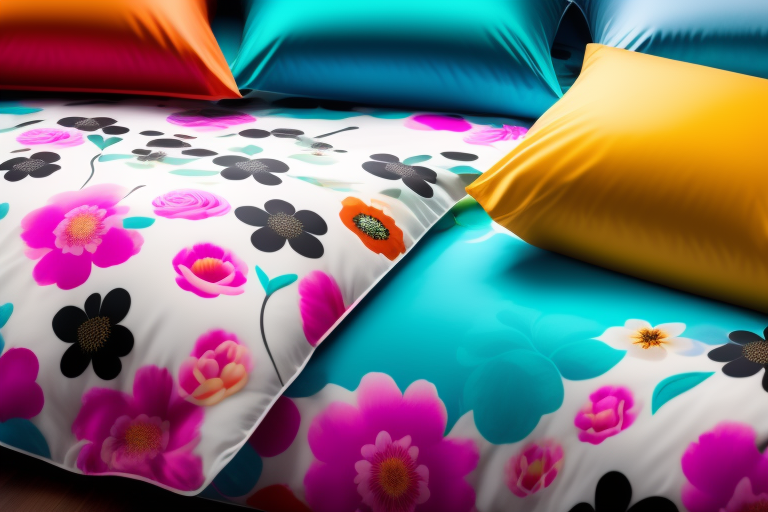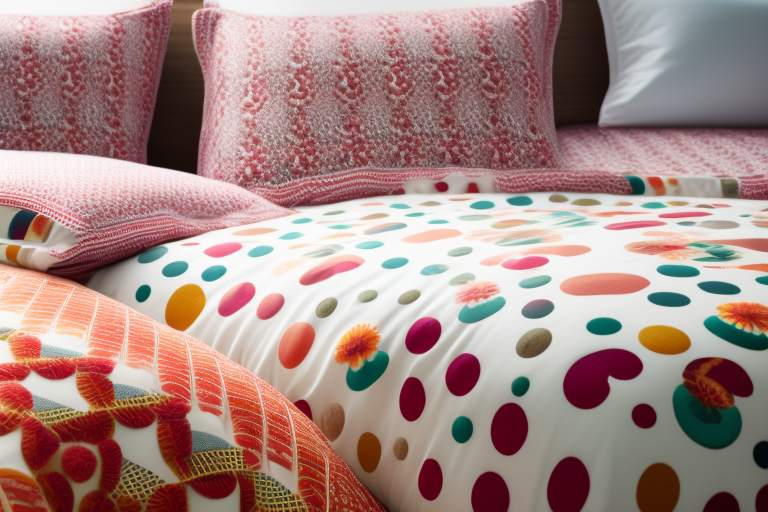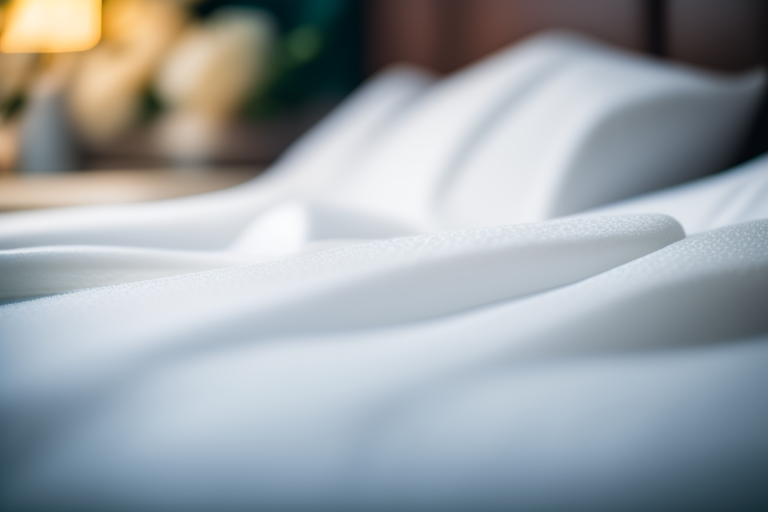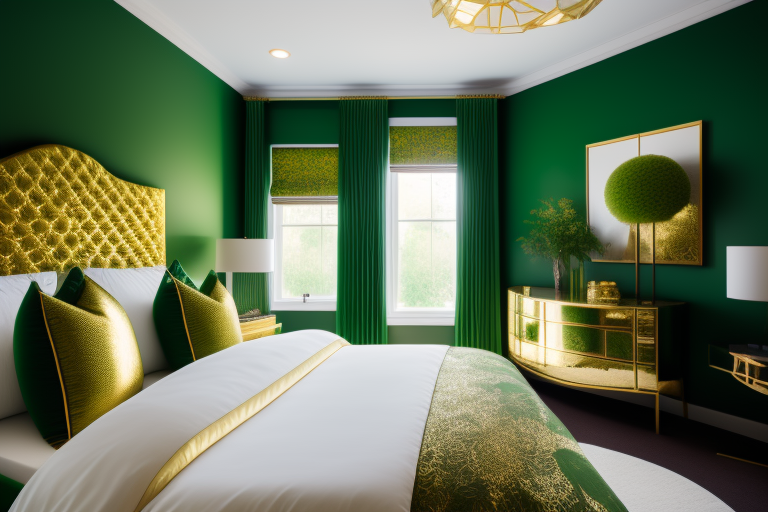When it comes to bedroom decor, one of the most impactful yet often overlooked elements is your choice of bedding colors and patterns. With so many options available today across different textiles and fabrics, it can get overwhelming trying to select the right bedding to match your existing decor while also keeping up with the latest trends.
This comprehensive guide will walk you through everything you need to know as a beginner when choosing the most popular, stylish, and cohesive bedding colors and patterns to elevate your bedroom. We’ll cover the pros and cons of today’s trending bedding color palettes and patterns, provide tips on mixing and matching, and show you how to pull together a beautiful, relaxing sleep space.
Why Bedding Color Matters
While it may seem like a minor decor detail, your bedding color choice speaks volumes about the overall look and feel of your bedroom. Here are some key reasons why choosing the right bedding colors is so important:
- Sets the tone and mood – Darker hues feel cozy and romantic, while lighter colors create an airy, relaxing vibe.
- Impacts your sleep – Some research shows blue tones promote better sleep.
- Makes a style statement – Bold, colorful patterns create an eclectic look vs. muted, neutral solids that are more minimalist.
- Ties your decor together – Bedding is a large surface area that should complement your color scheme.
- Reflects your personality – Vibrant, quirky prints for the free spirit or classic elegant solids for the traditionalist.
Take the time to evaluate what tone and style you want your bedding to convey before choosing colors and patterns. This will help narrow down your options.
Popular Bedding Color Trends
Bedding today comes in every color of the rainbow, but some hues rise above the rest in popularity. Here are some of the most fashionable bedding color choices right now:
Soothing White Bedding
Crisp, clean white bedding immediately evokes a sense of freshness and tranquility.
Pros:
- Light and airy ambiance
- Easy to mix and match with other colors
- Many material options like cotton, linen, and silk
Cons:
- Can look dull or clinical without texture
- Higher maintenance to keep clean
Tips: Add visual interest with woven textures, lace details, or embroidery. Accent with pops of color in pillows, throws, and artwork.
Soft and Muted Gray Bedding
Subtle shades of gray create a relaxed, neutral palette and provide a beautiful backdrop for adding colors.
Pros:
- Soothing, minimalist look
- Works with cool or warm color schemes
- Versatile for modern and traditional decor
Cons:
- Can feel bland if wrong shade of gray is selected
- Not as vibrant as some bolder colors
Tips: Choose gray with subtle blue, green, or taupe undertones. Layer on patterned shams and pillows.
Rich and Dramatic Black Bedding
Black bedding makes a bold style statement and anchors the space with sophistication.
Pros:
- Striking and elegant aesthetic
- Adds a luxe, opulent feel
- Visually grounding; great anchor color
Cons:
- Can feel too dark and dramatic for some
- Needs ample lighting to balance it out
Tips: Accent with metallic details, white linens, and lighter furniture pieces. Add ample lamps, sconces, and natural light.
And many other colors…
Calming Blue Bedding
Serene shades of blue from powder light to navy create a relaxing sleep space.
Earthy Green Bedding
Rich greens from sage to emerald green give off an earthy, zen vibe.
Cheery Yellow Bedding
Sunny yellow bedding instantly brightens and uplifts any room.
Playful Pink Bedding
Pretty pinks from blush to fuschia create a feminine, whimsical look.
Regal Purple Bedding
Jewel-toned purple bedding brings luxury and elegance to a bedroom.
Vibrant Red Bedding
Punchy reds from crimson to scarlet make a bold, sensual statement.
Chic Neutral Bedding
Soft beiges, taupes, creams and sand colors provide a calming neutral base.

Mixing and Matching Colors
One creative way to use color in bedding is by mixing different hues in the same bed. Here are some tips for combining colors successfully:
- Pick one color as dominant – 60-75% of bedding with other colors as accents.
- Choose one palette – stick to analogous hues (e.g. shades of blue/green) or complementary colors (blue & orange).
- Repeat colors from artwork or elsewhere in the room.
- Limit to 2-4 colors for cohesion. Too many looks chaotic.
- Vary textures & patterns – glossy satin sheets with a nubby wool blanket.
- Watch color ratios – don’t let accent colors compete with main hue.
Mixing colors creates depth and visual interest in bedding. Just be mindful of the overall color balance.
Top Bedding Patterns & Combinations
In addition to solid colors, patterns like florals, plaids, and geometrics can add appealing texture and dimension. Here are some of the most popular:
Charming Floral Bedding
Floral prints range from large bohemian blooms to tiny uniform repeats. They bring femininity and softness to a bedroom.
Pros
- Romantic, delicate look
- Endless variety of floral designs
- Works with solid sheets or pattern mixing
Cons
- Can feel cluttered if pattern is too large or bold
- Not as gender neutral as other prints
Tips: Look for muted, tone on tone floral prints for a more subtle effect. Use solids for pillows and shams.
Tailored Striped Bedding
From thin pinstripes to wide nautical bands, striped bedding has a crisp, classic vibe.
Pros
- Timeless and traditional
- Available in wide range of stripe widths/colors
- Visually elongates and brings order
Cons
- Has formal feel; not as playful
- Can be overwhelming if stripes are too wide
Tips: Use both vertical and horizontal stripes together. Anchor with solid sheets or shams.
Rustic Plaid Bedding
Rich plaids with interesting color and texture combos add cozy warmth.
Pros
- Casual, outdoorsy vibe
- Many pattern variations like buffalo check
- Great for cabin or farmhouse decor
Cons
- Too much plaid can feel visually busy
- Not as modern as other prints
Tips: Use plaid as the accent, like shams mixed with solid duvet. Add textural blankets.
Geometric Bedding for Modern Style
From chevron to abstract, geometric prints feel fresh and contemporary.
Pros
- Bold, graphic appeal
- Sleek, modern look
- Many shapes like triangles, diamonds, etc.
Cons
- Can feel too harsh or stark if colors/patterns are intense
- Not as warm and cozy as other prints
Tips: Soften geometric bedding with curvy lines in decor, billowy pillows, and natural fiber sheets.

Choosing Bedding by Room Style
Your bedding should coordinate with the overall decor and aesthetic of your master bedroom or guest room. Here are recommendations on selecting bedding based on room style:
| Room Style | Recommended Bedding Colors & Patterns |
|---|---|
| Modern minimalist | Neutrals like white, gray, black. Solid sheets with subtle patterns like tone-on-tone stripes or abstract prints. |
| Boho or eclectic | Bolder colors and busier mixed prints like floral and tribal patterns. More texture like crochet and macrame details. |
| Traditional and formal | Solids or tone-on-tone damask and jacquard prints. Rich colors like navy, burgundy, and dark green. Classic stripes and plaids. |
| French country | Softer muted colors and small scale floral prints. Distressed, vintage looking washed linens with ruffles and florals. |
| Coastal | Light blues, sandy tans, pale greens. Nautical stripes and preppy plaids. Weathered, sun-bleached linens. |
| Industrial modern | Charcoal, white, tan, and brick reds. Solid bedding or small polka dot prints. Cottons, linens, and denim bedding. |
| Glam Hollywood regency | White, silver, champagne, black and metallics. Silky satins with lush textures like faux fur. Geometric Art Deco patterns. Mirrored and tufted headboards. |
Choosing bedding suited to your existing room decor ensures everything flows together seamlessly.
Top Bedding Materials & Qualities
Bedding today is available in a wide array of materials at various price points. Here is an overview of the pros, cons, and best uses for different bedding fabrics:
| Material | Pros | Cons | Best For |
|---|---|---|---|
| Cotton | Breathable, soft, durable | Wrinkles easily | Everyday use, year-round comfort |
| Linen | Lightweight, relaxed texture, absorbent | Wrinkles easily, expensive | Warm weather, casual bedroom |
| Satin | Luxurious sheen, ultrasleek | Poor temperature regulation, delicate | Special occasion use |
| Silk | Most luxurious, temperature regulating | Very expensive, delicate | Ultimate indulgence & comfort |
| Flannel | Warm, super cozy, affordable | Can pill and look worn over time | Cold weather months |
| Jersey | Stretchy, moisture wicking, wrinkle resistant | Prone to holding odors | Athletes and hot sleepers |
| Microfiber | Durable, budget friendly, easy care | Not as breathable as natural fibers | Great affordable option |
Consider factors like climate, budget, and needed durability when selecting bedding materials. Combining different textiles can maximize visual interest and comfort.

Recommended Top Brands & Collections
With so many bedding options on the market, quality can vary tremendously. These top brands provide exceptional style, comfort, and durability:
Brooklinen
- Price range – $100-$400
- Best for – Minimalist solids and subtle patterns in luxe natural fibers like linen and cotton.
- Most popular collections – Classic, Luxe, and Linen collections.
Parachute Home
- Price range – $100-$500
- Best for – High quality, simplistic bedding focused on natural fibers like Egyptian cotton.
- Most popular collections – Sateen and Percale sheets.
Pottery Barn
- Price range – $50-$600
- Best for – Classic patterns and styles like traditional florals, plaids, and stripes. Natural fibers like organic cotton.
- Most popular collections – Belgian Flax Linen and 1900 Series cotton collections.
West Elm
- Price Range – $60-$500
- Best for – Modern and midcentury bedding in muted palettes with geometric prints and shibori designs.
- Most Popular collections – Belgian Linen and West Elm Basics.
Summary & Key Takeaways
- Consider the overall tone, style and color scheme you want your bedding to complement before choosing colors and patterns.
- Opt for popular hues like white, gray, blue and green for a tranquil vibe or vibrant shades like yellow, pink or red for an energetic feel.
- Mix colors thoughtfully by choosing a dominant shade and limiting accents to 2-4 complementary hues.
- Play with different textures and prints like florals, plaids, and geometrics to add visual interest to solid bedding.
- Match your bedding to your existing decor style, whether modern minimalist, traditional, or bohemian.
- Seek out high-quality bedding from reputable brands to ensure durability and comfort.
- Combining materials like crisp cotton sheets with a cozy flannel duvet delivers the best of both worlds.
With this thorough beginner’s guide, you now have all the information needed to confidently choose stylish, relaxing and fashion-forward bedding. Take your time, evaluate your space, and enjoy mixing colors, patterns and textures to create a beautiful sleep sanctuary. Sweet dreams!
Frequently Asked Questions
What are the most popular bedding colors right now?
Some of today’s trendiest bedding color choices are soothing whites, cozy neutrals like gray and beige, and tranquil blues and greens. Vibrant hues like yellow, pink, and red are also growing in popularity for an energetic vibe.
What’s the best bedding material for year-round comfort?
100% cotton bedding is highly breathable yet insulating, making cotton a top choice for comfort year-round. Linen and cotton/linen blends are other excellent options that regulate temperature beautifully.
How do I choose bedding to match my bedroom style?
Take cues from your existing room decor – opt for minimal patterns in neutral solids and subtle geometrics for modern style, traditional florals and plaids for classic decor, and bold bohemian prints for an eclectic look.
What are the pros and cons of white bedding?
White bedding has a fresh, clean look but can seem dull without texture. White also shows stains easily. Add interest with lace, embroidery or layering textures, and be diligent about protecting white bedding from soiling.
How do I mix and match bedding prints and colors?
Choose 1-2 dominant solids or prints in a cohesive color scheme, then layer on 1-2 accent colors and prints. Keep accent hues/prints to 25% or less of total bedding for balanced visual interest.
What thread count is best for bedding?
For cotton sheets, a 200-500 thread count gives the ideal balance of durability and softness. Higher thread counts above 500 don’t necessarily indicate better quality. Focus more on the cotton fiber quality and weave than thread count alone.
Where can I find high-quality designer bedding on a budget?
Check home goods stores like HomeGoods and online retailers like Amazon for discounts on top bedding brands. Subscribe to brand emails for sales alerts. Stock up during holiday weekends and end-of-season clearances for the best deals.








